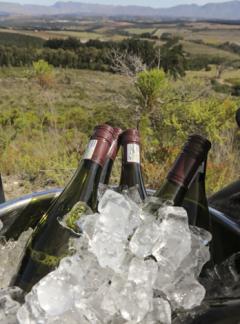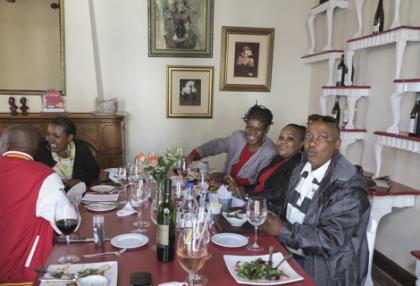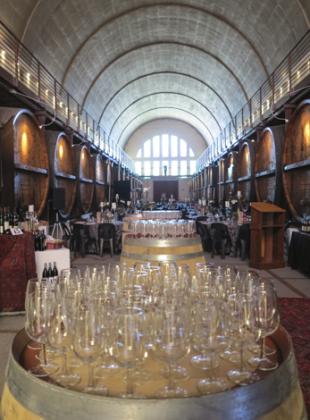Swartland and the Cape: The Revolution Starts here
POSTED ON 16/09/2013If the word pioneering is something of a cliché in the context of wine, the reality is that new wine regions in the New World often emerge as a result of a few brave souls going out on a limb. So it is with Swartland, the South African region currently making the biggest waves and justifiably garnering the most column inches. For long the ‘golden triangle’ of Stellenbosch, Paarl and Franschhoek made all the running, mostly with the usual suspects of cabernet sauvignon, chardonnay and sauvignon blanc. Today, Swartland, originally called Het Zwarte Land (the black country for its dark vegetation), is adding an exciting new string to the traditional Cape bow with wines based largely on Rhône styles and variations on the theme.
 Table Mountain from Constantia
Table Mountain from Constantia
It was Fairview’s Charles Back who paved the way for Swartland’s re-birth when he set up his Spice Route winery in Malmesbury. I met Eben Sadie more than a decade ago when he was sweating in the sultry Swartland heat as Charles Back’s winemaker. Putting his faith in Swartland and its unirrigated, old bush vines, Sadie branched out on his own to exploit the deep soils and Mediterranean climate. His syrah-based Columella and his white blend Palladius have inspired others to follow suit in creating similar Rhône-style reds and blends. The intensely spice and loganberry-like 2010 Columella apart, what caught my eye and refreshed my thirsty palate on my most recent Cape foray was the 2012 Skerpioen, a breathtaking blend of unirrigated bush vine chenin blanc and palomino that coats the tongue in honey, apple and nuttiness while remaining refreshingly lean, almost saline.

Porseleinberg is a fascinating project because it’s an exception to the general rule that Swartland’s success is necessarily based on the re-upholstering of old bush vines. Marc Kent, the producer of one of the Cape’s greatest Rhône-style reds in Boekenhoetsklouf, is the man behind Porseleinberg. In the inhospitably virgin rocky shale of The Porcelain Mountain’, Marc Kent has planted syrah vines, installing the talented winemaker, Callie Louw. When he’s not trying to stop the cattle from trampling the vines, Louw is achieving amazing results already from this blood-from-a-stone ‘terroir’. The first vintage of Porseleinberg, the 2010, is a wine with rosemary, tar and peppery perfumes and a vibrancy and a freshness of succulent rosemary and pepper-infused raspberry and cherry richness.
 Elegant Elgin picnic with Paul Cluver Wines
Elegant Elgin picnic with Paul Cluver Wines
On the same trip this summer (their winter) to Swartland’s harsh yet beautiful landscape of rolling grainfields and craggy mountain ranges, I once again caught up with Chris Mullineux and his wife Andrea. Chris and Andrea originally worked at Tulbagh Mountain Vineyards and then left in 2007 to set up Mullineux Wines. Now among the supernovas of the Swartland, Chris and Andrea have also shown how to make both superb reds and whites in this region. I tasted their latest releases, a superb chenin blanc-based 2012 Mullineux White, a wine of distinctive aromatics and textured ripe apple and stonefruit flecked honey and the distinctive 2011 Mullineux Syrah, all spice, tar, pepper and dark cherry in Northern-Rhône-like vein. The Mullineux also make the excellent value Kloof Street Red blend.
 Soweto wine shop managers visiting the Cape
Soweto wine shop managers visiting the Cape
‘People are saying the Swartland is about freshness but it’s not, the hallmark of the Swartland wines is texture’, says the irrepressible Adi Badenhorst who cut his teeth making wine at the historic Rustenberg farm in Stellenbosch. Lord of all he surveys, Badenhorst bought a pretty, characterful property in Swartland, where he makes the terrific value Secateurs range, a creamy apple and honey Chenin Blanc, a deiciously raspberryish Rosé and spicy berryish Red, along with an excellent AA Badenhorst Family White and its red counterpart, and the distinctive AA Badenhorst Funky White, SWIG, half-bottle, a deliciously nutty solera style lightly sherried white with gorgeous Bramley apple fruit.
Among other special wines to look out are David and Nadia Sadie’s 2012 Aristargos, a textured Rhône-style white blend with stonefruit flavours, grip and vigour and Craig Hawkins and Carla Kretzel’s fine 2010 Lammershoek Syrah, a spicy red whose camphor-like fragrance is supported by a spicy loganberry and blackberry fruit quality.
 A KWV auction dinner
A KWV auction dinner
Despite the modern wave of euphoria, wise heads counsel against overegging the Swartland pudding just because its winemakers are youthful and its honest wines are made without the winemaking polish that seduces palates with glossy new oak and concentrated richness. As an antidote to the evangelism, leading South African writer Michael Fridjhon points out that ‘there are celebrated wines whose unrelenting dullness positions them with the emperor’s new clothes in the costume museum of sartorial fiction’.
Be that as it may, most of the 23 wine producers who make up the SIP (Swartland Independent Producers) in this close-knit community of rural Swartland burn with such youthful energy and enthusiasm, that it’s hard not to be moved by their story and their wines. Indeed, it’s through this inspirational combination of soul and wine that Swartland is making an impression.
Among retail stockists with good Swartland wine representation:
The Wine Society has just made a Swartland offer:
http://www.thewinesociety.com/featured-range-safrica
Vincisive (www.vincisive.co.uk).
http://us4.campaign-archive1.com/?u=94f8343d6fc76837ae6a0131f&id=d153847aef
See also Swig (www.SWiG.co.uk)
Handford (www.handford.net)
SA Wines Online (www.sawinesonline.co.uk)
Fortnum & Mason (www.fortnumandmason.com)
Harvey Nichols (www.harveynichols.com)
Hedonism (hedonism.co.uk)
If you want to dig deeper into the Cape’s wine industry’s remarkable transformation from Napoleon and Cape Colony days to the vibrant 21st century wine scene, I thoroughly recommend the excellent Wines of the New South Africa, Tradition and Revolution (University of California Presa, www.ucpress.edu), by Tim James. Apart from his in-depth research and clear writing style, what I like about Tim James, one of South Africa’s leading wine writers, is that he’s objective, independent and doesn’t pull his punches.
 Courting popularity
Courting popularity

